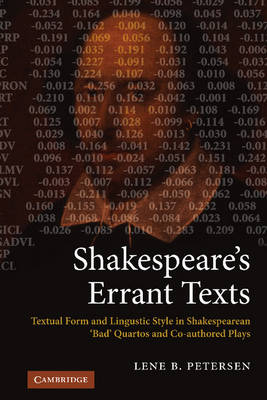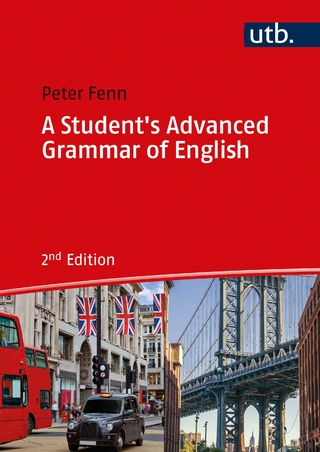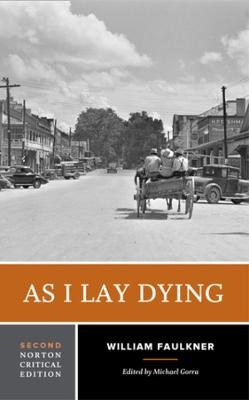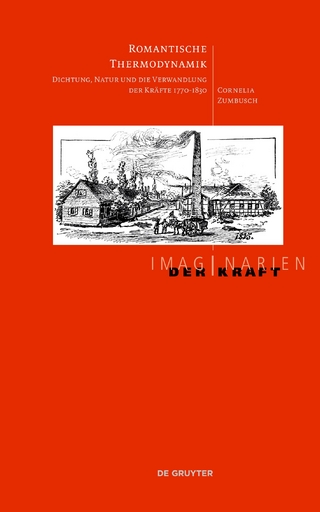
Shakespeare's Errant Texts
Cambridge University Press (Verlag)
978-0-521-76522-0 (ISBN)
If more than half of Shakespeare's texts survive in more than one version, and an increasing number of his texts appear to have been co-authored with other playwrights, how do we define what constitutes a 'Shakespearean text'? Recent studies have proposed answers to this crucial question by investigating 'memorial reconstruction' and co-authorship, yet significantly they have not yet considered properly the many formal and stylistic synergies, interchanges and reciprocities between oral/memorial and authorial composition, and the extent to which these factors are traceable in the surviving playtexts of the period. It is precisely these synergies that this book investigates, making this site of interaction between actorly and authorial input its primary focus. Petersen proposes new quantitative methodologies for approaching form and style in Shakespearean texts. The book's main case studies are Hamlet, Romeo and Juliet and Titus Andronicus - plays drawn from the middle of Shakespeare's working career.
Lene B. Petersen's work centres on Shakespearean textual studies, corpus linguistics/authorship and attribution studies and Renaissance theatre history. She has also written on traditional folk ballads and their transmission.
Foreword; Prologue; Part I. Oral-Memorial Transmission and the Formation of Shakespeare's Texts: 1. The Elizabethan dramatic industry and industrious Shakespeare; 2. Decomposing the text: oral transmission and the theory of the Zielform; 3. The popular play and the popular ballad: evidence of 'Quarto mechanics' in the multiple texts of Hamlet and Romeo and Juliet; Conclusion Part I; Part II. Recomposing the Author: Some Tools for Positioning the Role of the Playwright in Dramatic Transmission: 4. Introduction to quantitative textual analysis: computational stylistics, cognition and the missing author; 5. Stylometry and textual multiplicity I: contextual stylistics and the case of Titus Andronicus; 6. Stylometry and textual multiplicity II: testing the grading between authorship and 'orality' in the scenes of Romeo and Juliet and Hamlet; Conclusion Part II: evaluating the experiment; Epilogue; Appendix I. Scenic units in Q1 Hamlet/Der Bestrafte Brudermord and Romeo and Juliet/Romio und Julietta; Appendix II. 'Meet it is I set it downe': verbal evidence of Quarto mechanics in the short versions of Hamlet and Romeo and Juliet; Appendix III. Chapter 4: table of results for 257-Plays DA, using 50 principal components; Appendix IV. Examples of principal component screen plots for three-text Hamlet by scenes and three-text Romeo and Juliet by scenes only; Bibliography.
| Erscheint lt. Verlag | 24.6.2010 |
|---|---|
| Zusatzinfo | 16 Tables, black and white; 4 Halftones, unspecified |
| Verlagsort | Cambridge |
| Sprache | englisch |
| Maße | 152 x 229 mm |
| Gewicht | 610 g |
| Themenwelt | Geisteswissenschaften ► Sprach- / Literaturwissenschaft ► Anglistik / Amerikanistik |
| Geisteswissenschaften ► Sprach- / Literaturwissenschaft ► Literaturgeschichte | |
| Geisteswissenschaften ► Sprach- / Literaturwissenschaft ► Literaturwissenschaft | |
| ISBN-10 | 0-521-76522-6 / 0521765226 |
| ISBN-13 | 978-0-521-76522-0 / 9780521765220 |
| Zustand | Neuware |
| Haben Sie eine Frage zum Produkt? |
aus dem Bereich


